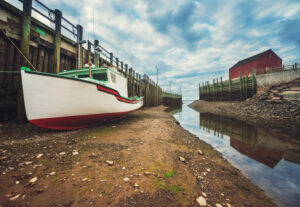Climate change considerations when launching a boat safely
Launching a boat safely in Canada, involves consideration of various factors, including weather conditions, water levels, and local regulations, all of which can be influenced by climate change. As of 2024, the relevance of climate change to boat launching in Canada can be understood in several key areas:
1. Weather patterns and unpredictability
• Storms and precipitation: Climate change leads to more frequent and severe weather events, including storms and heavy precipitation. This can affect launching schedules and safety measures.
• Wind patterns: Altered wind patterns can affect water conditions, making certain days less suitable for launching or navigating small boats. When planning boat trips, it’s crucial to monitor the overall weather conditions, but paying special attention to the forecasted wind levels for the day is essential. One good app to consider is Windy.com
2. Water levels
• Rising sea levels: Higher Sea levels can change the dynamics of traditional launching sites, potentially making some locations unsuitable for launching or docking. All boaters should have a good understanding of local tide changes. In some areas tides can have a huge differential between low and high tides. We are all familiar with the famous tides around the Bay of Fundy in New Brunswick which can have a tide differential of 16 metres. Ungava Bay in Northern Quebec can have a tide change of 10 metres. A wonderful phenomenon at the Skookumchuck Narrows can also be dangerous when boating at tide change. Twice daily, nature puts on a show as the tide changes and the flow of saltwater switches, reversing the direction and power of the incredibly turbulent Sechelt Rapids.

• Lake and river levels: Climate change affects precipitation patterns and evaporation rates, influencing water levels in lakes and rivers. Variability in water levels can impact the accessibility of boat launches. Many rivers are also affected by tide changes.
3. Temperature variation
• Ice cover: Warmer temperatures can lead to reduced ice cover on lakes and rivers, extending the boating season but also affecting traditional ice fishing activities and the safety of launching in early spring.
• Heatwaves: Extreme heat can impact boater safety and comfort, requiring additional precautions.
4. Ecological impacts
• Algal blooms: Warmer temperatures and changing water conditions can lead to increased algal blooms (colonies of algae), A harmful algal bloom occurs when toxin-producing algae grow excessively in a body of water. These blooms can affect surface coverage, obstructions, and put toxins in the water. Boat maintenance and clean up needs special attention if boating when algal blooms are present.
• Habitat changes: Climate change impacts aquatic ecosystems, potentially affecting navigable waters and the distribution of species, which can be a consideration for those launching boats for fishing.
5. Regulatory and infrastructure changes
• Adaptation measures: In response to climate change, local regulations regarding boating and water use may evolve, affecting where, when, and how boats can be launched. The implementation of marine protected areas under Canada’s Ocean Act addresses to protect marine ecosystems and could impact boating to boating areas, speed limits and anchoring.
• Infrastructure: Changes in water levels and weather patterns may require updates to boating infrastructure, such as docks and ramps, to ensure safe and accessible launching points.
• Reducing carbon emissions: Although more common in road vehicles, there is growing attention on the emissions from marine vessels. Measures may include promoting the use of electric boats or more efficient motors to reduce greenhouse gas emissions from boating activities.
• Public safety and access: In times of high-water levels the government may introduce a ban on boating.
In May of 2023 the Federal Transport Minister temporarily put a ban on any vessels on parts of the Ottawa River.
In 2024, climate change is indeed relevant to launching a boat safely in Canada. Boaters need to be increasingly vigilant about weather conditions, water levels, and regulatory updates. It’s also advisable to stay informed about local climate change impacts and adaptation strategies to ensure safe and enjoyable boating experiences.
Resources for launching a boat safely
Safe Harbour Insurance: How to launch a boat safely
Safe Harbour Insurance: Eco friendly boating doing your part
National Marine Manufacturers Association: New Global Research Outlines Portfolio of Technologies to Further Reduce Carbon Emissions from Recreational Boats
Georgia Straight Alliance: Boating in climate change